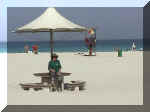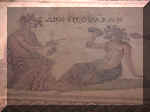|







Cyprus Sightseeing
 

|
Cyprus
wasn't all rocks and hard work. Some time was spent in normal touristy sort of
things. Swimming in the Mediterranean, drinking numerous metrios (Cypriot coffee -
this should be introduced to New Zealand some time!), shopping and general
sightseeing. This page will grow as extra pictures are processed. The shot on
the left is from our Emirates Airways Boing 777 as it approached Dubai in the early
morning. |

|
Our
stay in Dubai was brief, just 10 hours. In that time, we managed to catch up on some
sleep, and a few of the time zones that we had been through on our journey from Auckland,
New Zealand, via Melbourne, Australia, where we stopped off for lunch with friends, and
then on to Dubai. Also time to visit the gold sook to buy a gold chain (I've never
seen so much gold in one place before!), and a tour of the local sights courtesy of a
local taxi driver. The beach depicted at left was blindingly white,
and only sparsely populated.
Our flight on the Emirates Boing 777 was very smooth and relaxing. Cute
little TV screens in the backs of each seat. I wonder how long before this is
standard an all airlines?
On our return journey three weeks later, at 3am in the morning, the temperature was
36oC, with
100% humidity! This was definitely a shock to the system, but no one else
seemed to notice it! |

|
While
in Paphos, we took a little time out to visit the Roman mosaics in the village of Nea
Paphos, that is still in the process of being excavated. In the House of Dionysos,
this mosaic is a depiction of Dionysos, God of wine, himself, and of the nymph Akme,
seated opposite him drinking wine out of a bowl. Dionysos is offering a bunch of
grapes. These mosaics are not to be missed when visiting Paphos.
The house appears to have been built at the end of the 2nd century A.D., and
to have been destroyed and abandoned after a series of earthquakes that ruined Paphos and
most other towns in Cyprus in the first half of the 4th century A.D. |
 Back to Home Page Back to Home Page
|